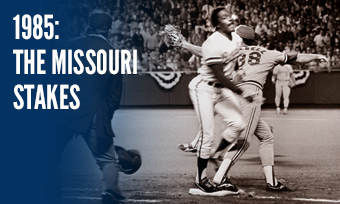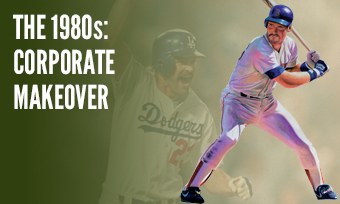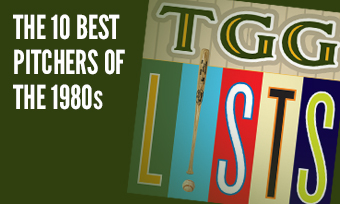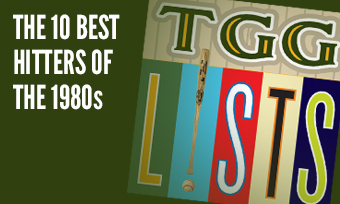The Yearly Reader
Leaders and Honors, 1985
Our list of baseball’s top 10 hitters and pitchers in both the American League and National League for the 1985 baseball season, as well as the awards and honors given to the game’s top achievers of the year.
The National League’s Top 10 Hitters, 1985
Bold type in brick red indicates league leader.
1. Willie McGee, St. Louis
Key Numbers: .353 average, 114 runs, 216 hits, 26 doubles, 18 triples, 10 home runs, 82 RBIs, 56 stolen bases.
Yet another escapee from the Yankees farm system as part of George Steinbrenner’s addiction to trading later for now, McGee set the NL mark for the highest batting average by a switch-hitter.
2. Dale Murphy, Atlanta
Key Numbers: 162 games, .300 average, 118 runs, 185 hits, 32 doubles, 37 home runs, 111 RBIs, 90 walks, 141 strikeouts, 10 stolen bases.
The ever-steady Murphy was becoming increasingly indispensable to a devolving Braves team, finishing a four-year run where he annually hit between 36-37 homers and drove in at least 100.
3. Pedro Guerrero, Los Angeles
Key Numbers: 137 games, .320 average, 99 runs, 33 home runs, 89 RBIs, 83 walks, 12 stolen bases, .422 on-base percentage, .577 slugging percentage.
After Guerrero began the year at third base—a position he continued to be uncomfortable at—the Dodgers moved him to the outfield on June 1; that month he hit 15 home runs, and then batted .460 in July—including a NL-record 14 straight plate appearances reaching base safely.
4. Ryne Sandberg, Chicago
Key Numbers: .305 average, 113 runs, 186 hits, 31 doubles, 6 triples, 26 home runs, 83 RBIs, 54 stolen bases.
Ryno’s follow-up to his 1984 MVP effort was equally effective, but the accolades were fewer on the awards circuit as the Cubs sank in the standings.
5. Tim Raines, Montreal
Key Numbers: .320 average, 115 runs, 184 hits, 30 doubles, 13 triples, 11 home runs, 41 RBIs, 81 walks, 70 stolen bases.
Alerting opposing teams that he was becoming as talented with the bat as he was with his legs, Raines hit .388 over his last 33 games; a year later, he would win the NL batting title.
6. Tom Herr, St. Louis
Key Numbers: .302 average, 97 runs, 180 hits, 38 doubles, 8 home runs, 110 RBIs, 80 walks, 31 stolen bases, 13 sacrifice flies.
Not since 1950 had anyone knocked in over 100 runs on less than 10 homers until Herr showed up.
7. Dave Parker, Cincinnati
Key Numbers: .312 average, 88 runs, 198 hits, 42 doubles, 34 home runs, 125 RBIs, 24 intentional walks, 26 grounded into double plays.
After five rough years of underachievement fueled by drug and weight problems, Parker’s monster season evoked his glory years at Pittsburgh.
8. Darryl Strawberry, New York
Key Numbers: 111 games, .277 average, 78 runs, 29 home runs, 79 RBIs, 73 walks, 26 stolen bases.
In his third year, the Mets’ “Chosen One” might have reached 40 homers and led the league had it not been for numerous injuries that saw him sit out a good chunk of the season’s first half.
9. Mike Schmidt, Philadelphia
Key Numbers: .277 average, 89 runs, 31 doubles, 5 triples, 33 home runs, 93 RBIs, 87 walks.
Despite his usual outstanding numbers, Schmidt finally lashed out at Phillies fans who had still yet to fully appreciate him. After his comments went to print, he went on the field wearing a Rastafarian wig and sunglasses to comically conceal his identity.
10. Jack Clark, St. Louis
Key Numbers: 126 games, .281 average, 26 doubles, 22 home runs, 87 RBIs, 83 walks.
Plucked away from the Giants, Clark provided the muscle as the only pure right-handed bat within a speedy, switch-hitting lineup, easily leading the club in home runs.
The American League’s Top 10 Hitters, 1985
1. Rickey Henderson, New York
Key Numbers: 143 games, .314 average, 146 runs, 172 hits, 28 doubles, 5 triples, 24 home runs, 72 RBIs, 99 walks, 80 stolen bases.
Seemingly at his most content (and therefore his best) when playing for Billy Martin, Henderson scored the most runs by a major leaguer since 1949, and became the first since Jimmie Foxx in 1939 to average over a run per game.
2. George Brett, Kansas City
Key Numbers: .335 average, 108 runs, 184 hits, 38 doubles, 5 triples, 30 home runs, 112 RBIs, 103 walks, 31 intentional walks, .585 slugging percentage.
Ballplayers across the country were seeking the conditioning recipe used by Brett after his offensive revival in 1985.
3. Don Mattingly, New York
Key Numbers: .324 average, 107 runs, 211 hits, 48 doubles, 3 triples, 35 home runs, 145 RBIs, 15 sacrifice flies.
One of the reasons Rickey Henderson scored so many runs was because Mattingly was there to knock him in; 26 of his 35 home runs came after the All-Star Break.
4. Eddie Murray, Baltimore
Key Numbers: .297 average, 111 runs, 173 hits, 37 doubles, 31 home runs, 124 RBIs, 84 walks.
On August 26 at California, Murray achieved his third (and last) career hat trick of home runs while driving in a personal-best nine runs.
5. Kirk Gibson, Detroit
Key Numbers: .287 average, 96 runs, 37 doubles, 5 triples, 29 home runs, 97 RBIs, 30 stolen bases, 4 caught stealing.
Though the Tigers slipped from invincible form, it wasn’t because of Gibson—who came as close to 30-30 as he ever would, failing to go deep in either of his last four games in pursuit of #30.
6. Wade Boggs, Boston
Key Numbers: .368 average, 653 at-bats, 107 runs, 240 hits, 42 doubles, 8 home runs, 78 RBIs, 96 walks, .450 on-base percentage.
Boggs won his second batting title while going hitless in only 26 games; his 240 hits were the most by any major leaguer since 1930.
7. Jesse Barfield, Toronto
Key Numbers: .289 average, 94 runs, 34 doubles, 9 triples, 27 home runs, 84 RBIs, 22 stolen bases.
The rise of Barfield, after three part-time seasons, was a key factor in the Blue Jays making the postseason for the first time.
8. Darrell Evans, Detroit
Key Numbers: .248 average, 81 runs, 40 home runs, 94 RBIs, 85 walks.
The 38-year-old veteran, whose career appeared ready to flicker out a year earlier, became the oldest player to lead the AL in home runs—and the first to hit at least 40 in both leagues.
9. Phil Bradley, Seattle
Key Numbers: .300 average, 641 at-bats, 100 runs, 192 hits, 33 doubles, 8 triples, 26 home runs, 88 RBIs, 12 hit-by-pitches, 22 stolen bases.
In the pre-Ken Griffey Jr. era of Seattle baseball where every year it seemed to be a different guy leading the charge offensively, it was Bradley’s turn; his 192 hits remained the Seattle team record until Alex Rodriguez exploded in 1996.
10. Cal Ripken Jr., Baltimore
Key Numbers: 161 games, .282 average, 642 at-bats, 116 runs, 181 hits, 32 doubles, 5 triples, 26 home runs, 110 RBIs, 32 grounded into double plays.
This was the first of six seasons during Ripken’s epic consecutive-game streak in which he actually didn’t lead the league in games played. (How? Because rained-out Orioles games not made up kept Ripken below the 162 threshold reached by others.)
The National League’s Top 10 Pitchers, 1985
1. Dwight Gooden, New York
Key Numbers: 1.53 ERA, 24 wins, 4 losses, .857 win percentage, 35 starts, 16 complete games, 276.2 innings, 268 strikeouts, 22 stolen bases allowed, 21 grounded into double plays.
If there was any sophomore jinx related to the phenomenal Gooden, then it was on the confounded batters he faced. With the second-lowest season ERA (after Bob Gibson’s 1.12 in 1968) since the Deadball Era, the 20-year old was a unanimous choice for the NL Cy Young Award.
2. John Tudor, St. Louis
Key Numbers: 1.93 ERA, 21 wins, 6 losses, .724 win percentage, 36 starts, 10 shutouts, 275 innings, 49 walks.
Any other year, and odds are that Tudor would have grabbed the Cy—but not in the year of Dr. K. Tudor did, however, match Gooden for the year’s longest streak of consecutive scoreless innings (31.2)—starting one day after Gooden began his.
3. Orel Hershiser, Los Angeles
Key Numbers: 2.03 ERA, 19 wins, 3 losses, .864 win percentage, 34 starts, 239.2 innings, 23 stolen bases allowed, 25 grounded into double plays.
In an exceptional second full season, Hershiser tossed two one-hitters—the first of which came against San Diego and Tony Gwynn, the only batter to reach base, twice. Each time he reached, he was thrown out attempting to steal.
4. Fernando Valenzuela, Los Angeles
Key Numbers: 2.45 ERA, 17 wins, 10 losses, 35 starts, 272.1 innings, 101 walks, 10 wild pitches, 21 grounded into double plays.
In a start to the season that dared to draw comparisons to the incredible onset of his 1981 campaign, Valenzuela didn’t allow an earned run over his first 41.1 innings thrown. (He did allow four unearned tallies, though.)
5. Bryn Smith, Montreal
Key Numbers: 2.91 ERA, 18 wins, 5 losses, .783 win percentage, 32 starts, 222.1 innings, 41 walks, 21 grounded into double plays.
Within a rather common statistical biography that could have led to the nickname “Mr. .500,” Smith’s highly winning 1985 campaign was bumped up thanks to his cleaning up (13-0, 2.25 ERA) of three below-.500 teams: The Phillies, Cubs and Braves.
6. Rick Reuschel, Pittsburgh
Key Numbers: 2.27 ERA, 14 wins, 8 losses, 1 save, 31 appearances, 26 starts, 194 innings.
Talk about contrasting reversal of fortunes: Reuschel won Comeback Player of the Year honors for a wreck of a team that plummeted to 104 losses; the Bucs’ rotation was a humiliating 28-64 without him.
7. Joaquin Andujar, St. Louis
Key Numbers: 3.40 ERA, 21 wins, 12 losses, 38 starts, 269.2 innings, 11 hit-by-pitches, 29 stolen bases allowed, 32 grounded into double plays.
The fiery Andujar, who boycotted the All-Star Game (because they wouldn’t let him start) and received a 10-day suspension for his World Series tirade against umpire Don Denkinger, claimed 20-win status for a second straight year—but the Cardinals shipped him to Oakland after the season anyway, pointing to a rough finish (5.82 ERA from July 31 through the postseason).
8. Dennis Eckersley, Chicago
Key Numbers: 3.08 ERA, 11 wins, 7 losses, 25 starts, 169.1 innings, 19 walks.
Eck went on a winning flourish down the stretch to keep the Cubs’ staff from being the first in franchise history without a 10-game winner in a non-strike season.
9. Tom Browning, Cincinnati
Key Numbers: 3.55 ERA, 20 wins, 9 losses, .690 win percentage, 38 starts, 261.1 innings.
Browning became the first rookie in 31 years to win 20 games. He wouldn’t do it a second time in any of his other 11 seasons.
10. Danny Cox, St. Louis
Key Numbers: 2.88 ERA, 18 wins, 9 losses, 35 starts, 241 innings.
Joaquin Andujar wasn’t the only Cardinals pitcher who got feisty in October; after earning a critical victory—his career-high 18th—against the Mets in his last regular season start, he quickly retreated to Georgia and punched out his ex-brother-in-law, who was threatening Cox’ sister.
The American League’s Top 10 Pitchers, 1985
1. Bret Saberhagen, Kansas City
Key Numbers: 2.87 ERA, 20 wins, 6 losses, .769 win percentage, 32 starts, 253.1 innings, 38 walks.
The AL’s youthful answer to Dwight Gooden, without the glitz—until it came his turn to shine in the postseason.
2. Dave Stieb, Toronto
Key Numbers: 2.48 ERA, 14 wins, 13 losses, 36 starts, 265 innings, 96 walks.
The record simply doesn’t match the ERA, and here perhaps is why: In nine no-decisions, Stieb’s ERA was 2.03. On top of that, here was a sign of further frustration to come: Stieb took a no-hitter into the ninth inning at Chicago on August 24, and immediately gave up back-to-back home runs before being removed.
3. Ron Guidry, New York
Key Numbers: 3.27 ERA, 22 wins, 6 losses, .786 win percentage, 33 starts, 259 innings, 42 walks, 30 grounded into double plays.
Buoyed by generous run support (5.6 per start), Guidry gave it a last great ride before his career slowly but surely began to peter out.
4. Charlie Leibrandt, Kansas City
Key Numbers: 2.69 ERA, 17 wins, 9 losses, 33 starts, 237.2 innings, 21 grounded into double plays.
Rescued from the minors after disappointing the Reds earlier in the decade, Leibrandt was a sidebar success story relative to Bret Saberhagen—even if he had a better ERA.
5. Bert Blyleven, Cleveland-Minnesota
Key Numbers: 3.16 ERA, 17 wins, 16 losses, 37 starts, 24 complete games, 5 shutouts, 293.2 innings, 206 strikeouts, 34 stolen bases allowed, 21 grounded into double plays.
A 1970s-era relic in a time of diminishing returns (quantity-wise) from starting pitchers, Blyleven played the ultimate workhorse well—and even got the trade he had long sought from Cleveland.
6. Mike Moore, Seattle
Key Numbers: 3.46 ERA, 17 wins, 10 losses, 34 starts, 247 innings.
Moore tied a Mariners record with 17 wins—a year after tying another team mark with 17 losses.
7. Dan Quisenberry, Kansas City
Key Numbers: 2.37 ERA, 8 wins, 9 losses, 37 saves, 12 blown saves, 84 appearances, 129 innings, 16 walks.
Quisenberry remained the AL’s top closer, leading the league in saves for the fourth straight year.
8. Danny Jackson, Kansas City
Key Numbers: 3.42 ERA, 14 wins, 12 losses, 32 starts, 208 innings, 26 grounded into double plays.
Another young breakout arm for the Royals, Jackson allowed just seven home runs—two over 98.2 innings at home.
9. Bob James, Chicago
Key Numbers: 2.13 ERA, 8 wins, 7 losses, 32 saves, 9 blown saves, 69 appearances, 110 innings, 23 walks.
Bouncing between the Expos and Tigers over the previous seven seasons, James was finally given a full-time platform as closer and set a White Sox saves record (soon to be annihilated by Bobby Thigpen)—all despite missing three weeks in July with a leg injury.
10. Dan Petry, Detroit
Key Numbers: 3.36 ERA, 15 wins, 13 losses, 34 starts, 238.2 innings, 24 grounded into double plays.
Petry’s run of seven straight winning records to start his career would come to an end in 1986, but for now he remained every bit the equal to star ace teammate Jack Morris.









